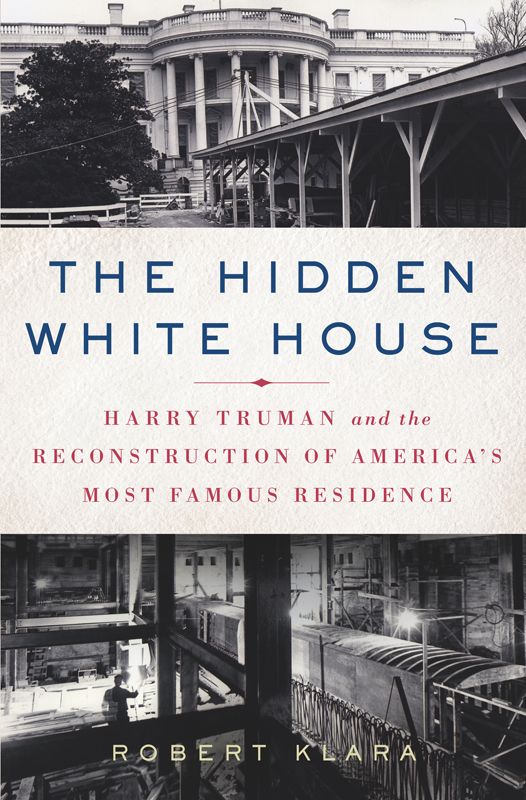
The Hidden White House
Harry Truman and the Reconstruction of America's Most Famous Residence
کتاب های مرتبط
- اطلاعات
- نقد و بررسی
- دیدگاه کاربران
نقد و بررسی

July 15, 2013
In 1949, under the direction of President Truman, an extensive reconstruction of the White House began. Home improvements might not seem like much to base a story on, but Klara (FDR’s Funeral Train) turns the tale of this controversial project into a delightful and informative narrative. Truman already had plenty to worry about during his presidency (e.g., the Cold War, low approval ratings), and swinging refrigerator-sized chandeliers, ghostly creaks and groans, and a piano falling through the floor weren’t helping to ease his mind. When the White House was finally examined, inspectors discovered dangerously compromised beams, scorched timbers leftover from the fire set by the British during the War of 1812, and distressing evidence that the entire building was sinking. Over the course of three years, all but the exterior walls were demolished and rebuilt, and both Margaret Truman and former First Lady Eleanor Roosevelt remarked that the new White House felt like a cheap hotel. Klara brings the reconstruction’s major players—including Truman and his family, architect Lorenzo Winslow, and contractor John McShain—to life in sharp prose, infusing this cracks-and-crevices exposé with plenty of entertaining drama. B&w photos throughout. Agent: Gary Heidt, Signature Literary Agency.

October 1, 2013
The tale of the refurbishment of "America's most famous house." It may come as a shock to learn that while President Harry Truman was working on the strategic doctrine named for him, the White House was declared unlivable and he and his family had to move out. In a worthy follow-up to his debut, FDR's Funeral Train: A Bereaved Widow, a Soviet Spy and a Presidency in the Balance (2011), Klara uncovers the shocking story of how the White House--a potent symbol of the nation's power, identity and history--almost collapsed and was reconstructed during the Truman administration. The author combines his proven skills as a researcher with his knowledge of architecture acquired from his earlier career at Architecture and other publications. His account of the history of the White House and the transformations made to the structure at the request of its successive occupants becomes a lively case study of how a lack of knowledge can lead to disastrous results. The expansion of formal dining facilities desired by Edith Roosevelt destabilized the walls that supported the slate roof, and this led to the occasion when one of Margaret Truman's baby grand pianos plunged "through the parquetry, through the subfloor and punch[ed] through the plaster ceiling downstairs." Structural weakness, dry root, and the destruction of old beams notched and sliced to carry lead pipe, gas pipe, hot water pipe, telegraph and telephone had taken their toll. Klara really shines as he relates the back and forth among the White House and Congress and the architects, federal building inspectors and building crews as they diagnosed the problems. An enjoyable read and a useful guide for visitors to the nation's capital.
COPYRIGHT(2013) Kirkus Reviews, ALL RIGHTS RESERVED.

September 1, 2013
Did you know that almost none of the original interior structure of the White House still exists? Klara (FDR's Funeral Train: A Betrayed Widow, a Soviet Spy, and a Presidency in the Balance) provides a fascinating chronicle of how this famous landmark, found to be on the verge of structural collapse during Harry Truman's presidency, was gutted and rebuilt from the inside out. His absorbing narrative details every aspect of the renovation, including the conflicts, political gamesmanship, and compromises that occurred among the executive branch, Congress, and various public and private entities involved in this momentous commission. Throughout, Klara cleverly shows how world events, such as an attempted presidential assassination and the impending Cold War arms race, affected the design and outcome of the project. VERDICT While Margaret Truman's The President's House: 1800 to the Present; The Secrets and History of the World's Most Famous Home is full of historical anecdotes relating to the White House, some of which are about the rebuilding that she experienced firsthand as the president's daughter, Klara's focused history will intrigue architectural history enthusiasts along with presidential history buffs and others who will appreciate a part of White House history that has been forgotten by many. [See Prepub Alert, 4/22/13.]--Mary Jennings, Camano Island Lib., WA
Copyright 2013 Library Journal, LLC Used with permission.

September 15, 2013
By 1949, according to Klara, the White House was in an advanced state of decrepitude. Wooden beams were rotting, floors were dangerously unstable, some timbers had scorch marks from the British burning during the War of 1812, and the foundation was sinking at an accelerated rate. So a three-year renovation project was launched, which basically gutted the interior while keeping the faade intact. In this gossipy, sometimes amusing, sometimes irritating account, Klara describes how the interior arrived at its present form. Characters, famous and relatively obscure, flit in and out of the narrative, creating frequently humorous situations. Klara writes with a strong sense of the ironic, and he is careful to point out that more substantive world events were going on under Truman's watch. This is a light, generally enjoyable look at a historical sideshow.(Reprinted with permission of Booklist, copyright 2013, American Library Association.)




















![Design Like You Give a Damn [2]](https://dl.bookem.ir/thumbnails/150/ISBN13/9781613122860.jpg)




دیدگاه کاربران